7 And The Pendulum Swings: Intellectual and Religious Developments in the British Colonies
Enlightenment and First Great Awakening
Jim Ross-Nazzal, PhD and Students
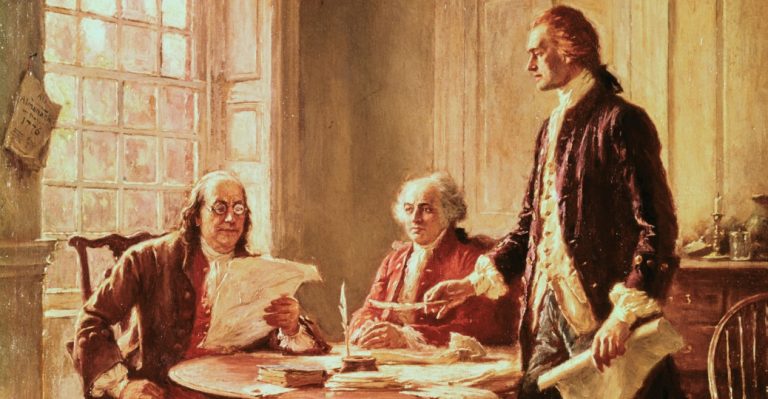
Two seemingly divergent ways of looking at the world were more in common in fact than on paper. Although the latter was a reaction to the former, the Great Awakening failed to achieve the immediate goals of its leaders. But instead, one result of the Great Awakening was the development of a new, independent thinking that facilitated the intellectual underpinnings of the eventual American War for Independence.
The flip side of the witch craze is the Enlightenment. Regardless if it were people like the Puritan minister Cotton Mather who had one foot firmly grounded in the past and another treading into the light, or his sometime associate and fellow author of the Declaration of Independence, Benjamin Franklin who is a poster child of the Enlightenment, enlightened thinkers sought to understand the universe, to order the universe by using scientific methods, then identifying problems in the world, in order to affix solutions using science and reasons, as opposed to superstition. Newton and Voltaire were two European examples. The Enlightenment was not anti-god or divorced from a transcendental being, rather, as Voltaire surmised, the Christian god was like a clock-maker. God created the world like a clock-maker makes clocks. The clocks go up upon mantles and they are left alone, only to be worked on by the clock-maker when the clocks break. God therefore is not intimately involved in the affairs of people but rather set the universe in motion, sat back and allowed people to engage their lives, and only gets involved in the world when the world is broken. That’s known as the Clock-Maker Theory.
Puritanism began to wane in New England as a burst of intellectual activity began in Europe. Europeans seemed to have sensed that change coming. People were bound to daily and seasonal rhythms, thus people new of the coming of the ‘new light’ -an emergence from the old darkness. The intellectual and spiritual aspects of the Enlightened happened concurrently and found their way across the Atlantic.
According to some historians, the distillation of the Enlightenment was:
-humans could understand the world through reason opposed to responding to omen, myth, magic, superstition, or supernatural beliefs.
-because of reason. Understanding of the world could be used to create a more orderly and humane society. First you identify problems, then you fix those problems.
Even though the Enlightenment did not hit the British colonies in North America until the 18th century, Enlightenment’s beginnings can be seen from Copernicus in the 1500s when he announced the earth was not the center of the universe, but instead centered around the sun. Isaac Newton’s Princepea in 1687 argued that natural laws logically extend to society, particularly to politics. Voltaire used the Clock Maker theory to describe the relationship between God and humanity. God was not unlike a clock maker. Upon creating the clock the clockmaker stands aside and lets the clock operate on its own, interceding only when the clock fails to operate correctly. The Divine Right of Kings was challenged by Europe’s intellegencia. There was Rousseau’s Social Contract (1762), Mary Wollstonecraft’s Vindication of the Rights of Women (1792), etc. and all were based on natural rights thinking.
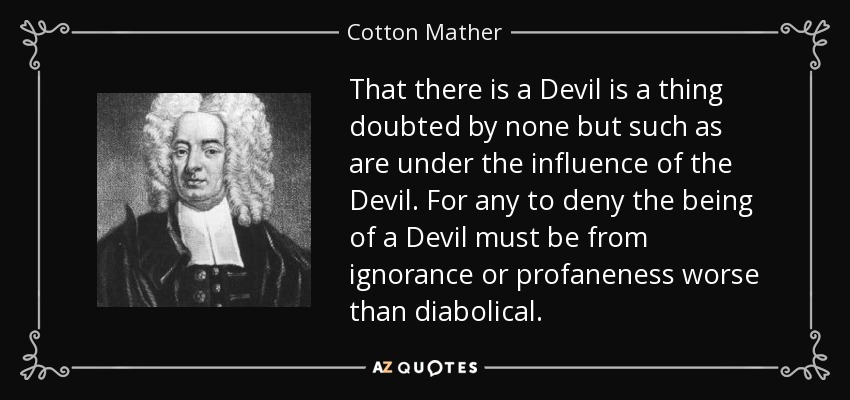
Aurore Angue Mbo looked at how Cotton Mather was both part of the witch craze as well as an Enlightened scientist.[1]
Cotton Mather, born in 1663, was a well-known New England Puritan minister and prolific author who was best-known for his implication in the Salem which trials conducing the writing of a book about witchcraft called “On Witchcraft” as well as “The Wonders of the Invisible World”, published where he explained how to identify a witch. His work is reminiscent of a powerful evangelical sermon to the masses, to emphasize the signification of devotion in regular day to day existence. The timing of these events was important for the general public and the church as it was an attempt to bring out the consciousness of the New England population after the occurrence of the Salem witchcraft trials between 1692 and 1693.[2]
Mather makes a few references to his precise work, the legal prosecution of witchcraft as a crime, and the efforts of the church as a predetermined destiny. Mather expressed the reluctance of involving the legal system to prosecute witch craft unless it is approached carefully and taken seriously as it is shown through his own diary. Through his works cared about the protection and welfare of the public commonwealth. Mather expresses that the significance of the New England colonies to evolve and be triumphant would affect the economy of America and morality of other parts of the world in the future.[3]
Mather was once fascinated in elevating awareness to a supernatural demonic force performing with intent (he believed) that was once responsible–in part–for destroying the moral fabric of society and influencing humans of New England to harm one another. It was the trigger of the writing of his books about witchcraft in which notably “The Wonders of the Invisible World”, he describes the righteousness of the Salem trials.[4] However, in his diary he is no longer blaming the “witches” of folklore for the troubles that they have been facing. He later wrote about being regretful for being an actor of the trials. It is after the publication of “More Wonders of the Invisible World” written by Robert Calef, which displays a very different account than Mather’s that put Cotton on the defensive for the rest of his life. The shift from being a Puritan preacher to a prolific scientist has started.[5]
Mather became slowly an important figure of the Enlightenment movement as he started to work with Benjamin Franklin who was later known as an American politician who became one of the founding fathers of the United States. His work sparkled after the 1721 Boston smallpox pandemic that highlights the first American’s inoculation. The purpose of the “inoculation” was to transfer the actual virus from a victim to the patient, producing mild, but occasionally serious, smallpox. Tony Williams, author of “The pox and the covenant” describes through the perspective of prominent Puritan priest Cotton Mather and Benjamin Franklin. Believers, like Cotton Mather, did not have objection to the scientific discoveries that happened during the Enlightenment era as Mather was also a naturalist. Naturalism conceives of philosophical activity as an extension of scientific activity. Chosen for the English Imperial Society, he exchanged with different individuals in London and all through Europe. As the plague spread, he asked inoculation, yet just a single Boston doctor, Zabdiel Boylston, took him up on it. Others condemned it. Because of the negative views on the practice of inoculation in which Boylston overlooked, numerous abusive newspaper essays and decrees were produced to prevent inoculations from happening. Those attacks appeared in New-England Courant which was published by James Franklin who Benjamin, assumed a minor job but later became Mather’s mentee as he influenced him to be a scientist. Eventually, Mather’s adversaries overlooked proof that Boylston’s vaccination worked, liking to announce that it was pointless, hazardous or an infringement of God’s will. Despite the opposition of the church, Mather still worked on the inoculation experiment.[6]
It is important to note that the enlightenment movement precipitated into a cultural revolution. Essentially, the Cultural Revolution that was witnessed was based on the ideals and values fronted by the key players in the enlightenment process. These ideas served to change the political, economic and philosophical landscape as it was perceived at the time. For instance, the enlightenment movement led to increased skepticism among populations on the absolute authority that was possessed by the church and the monarchy. Essentially, the enlightenment period ushered in the notions and ideals of democracy and equality in society.[9]
The Enlightenment in New England
John Winthrop, Jr. (1606-1676) was an on again, off again, on again governor of Connecticut who maintained an iron works (nails, horse shoes, other iron needed products), glass works, grist mill (ground grains into flour), dabbled in chemistry such as trying to extract salt from sea water, operated the first blast furnace in the colonies, was a physician, maintained a private library, and an amateur astronomer.[10]. Winthrop supposedly espoused Rationalism: the belief that reason (evidence) is the source of knowledge, not belief or superstition. However, not everything Winthrop did was evidence-based, such as his work as a doctor.
“Few physicians lived in Connecticut in those days, and they had scant medical knowledge. John Winthrop Jr., for example, concocted remedies that seem bizarre by today’s standards. To cure the plague, he burned and pulverized toads. His remedies also seemed weird by 19th century standards. Oliver Wendell Holmes, a physician, studied Winthrop’s papers and tried to figure out what he had given people. Holmes concluded he concocted his favorite remedy, rubila, from nitre (saltpeter) and some antimony (also known as kohl). ‘A little salt of tin may have been added, and there are hints of the presence of powdered ‘unicorn’s’ horn’ (narwhal tooth),’ Holmes wrote in a medical essay. ‘One can imagine yet other horrors.'”[11]
“From about 1650 to his death in 1676, post riders along the Boston Post Road routinely carried Winthrop’s diagnoses and medications from his home in New London. Walter W. Woodward described John Winthrop Jr. as ‘one of New England’s leading practitioners of alchemical medicine. Sick people inundated him with medical requests. In his book, Prospero’s America: John Winthrop, Jr., Alchemy, and the Creation of New England Culture, 1606-1676, Woodward wrote, ‘New London became a hospital town to which patients came from all over New England seeking cures for a host of medical conditions. To help meet the New England-wide demand for his medicines, Winthrop distributed them through a network of female practitioners, elite wives who incorporated Winthrop’s color-coded packets of medicines into their own healing services.'”[12]
His female practitioners included Elizabeth Davenport, wife of John Davenport, the Puritan minister who co-founded New Haven; Anna Mason, wife of John Mason, Winthrop’s deputy governor, and Mrs. Newton, probably the wife of Roger Newton, Milford’s minister. Even Roger Williams in Rhode Island wrote to John Winthrop Jr. seeking a cure for a parishioner’s daughter. In the 17th century, doctors considered purging a remedy for all kinds of illnesses. John Winthrop Jr. used his reddish powder, rubila, to stimulate powerful diarrhea and vomiting. He tried to cure plague, smallpox, fevers, king’s evil (scrofula), insanity, falling sickness, broken bones, dislocations and burning with gunpowder. For inflammations, he recommended blood letting. For fevers, fasting in the early stages. And then there were his medications. Holmes classified them as simple, mineral and mystical. “Simple” included herbs like St. John’s wort, Clown’s all-heal and parsley. His rubila belonged to the category of mineral drugs, such as lime, saltpetre, Armenian bole, crocus metallorum, sulphuret of antimony and nitre. Nitre, wrote Holmes, was a pretty safe medicine in moderate doses, ‘and one not likely to keep the good Governor awake at night, thinking whether it might not kill, if it did not cure.’”[13]
“And then John Winthrop Jr. had his mystical drugs. He called his chief mystical drug his black powder. It supposedly cured the plague, smallpox and all sorts of fevers. He made it by putting live toads into an earthen pot so as to half fill it. He then baked and burned them in the open air until he could pound them first into a brown, then into a black powder. He got a truly bizarre recipe from Sir Kenelm Digby for curing fever and ague: ‘Pare the patient’s nails; put the parings in a little bag, and hang the bag around the neck of a live eel, and put him in a tub of water. The eel will die, and the patient will recover.’ Another cure was a little more straightforward. Good wine, he wrote to a friend, was the best medicine for the friend’s wife.”[14]
Colonial medicine, and the Enlightenment, will advance. About 50 years after the death of John Winthrop Jr., in Boston, Cotton Mather, and others, focused on the use of inoculations to stem the tide of a small pox epidemic.
When the smallpox epidemic broke out in Boston, the medical community was split over what to do. Those against inoculation argued doing so was against God’s will, might hurt people who are otherwise healthy. That the idea was based on folklore (Mather got the idea from a west African slave) while others found the idea to be just scientifically untested and thus dangerous.[16] One person in Boston’s medical community who held a medical degree, Dr. William Douglas, “feared that unchecked use of inoculation would only quicken the spread of disease throughout the city.”[17] In the end, inoculation won out: only 2% of those inoculated died of smallpox verses nearly 15% of the non-inoculated, thus proving Mather correct.[18]
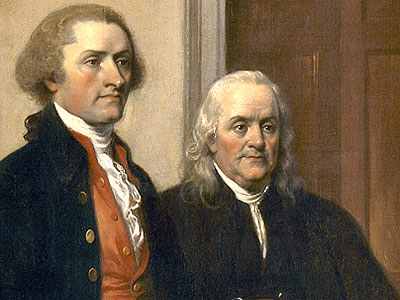
Franklin and Jefferson
Under the pen name, Mrs. Duegood, Benjamin Franklin wrote articles against the pulpit and organized religion and in favor of education for his local Philadelphia newspaper. He threw off his common beginnings and rose to the pinnacle of the intellectual scene.
Franklin was born in 1706 and moved to Philadelphia at the age of 17. By 24 he owned his own print shop and published the Pennsylvania Gazette. At 27 he began publishing Poor Richard’s Almanac and retired at age 42. He founded libraries, fire companies, and the University of Pennsylvania. His debating club turned into the American Philosophic Society. He was an inventor who created such things as the self-named Franklin stove, a lightning rod, the glass harmonica, ship designs, and wrote on government and political theory.
Anglo-American intellectuals like Franklin tended to be self-taught and drew their inspiration from European Enlightenment ideals, which combined confidence in human reasons with skepticism towards beliefs not founded on science or strict logic, such as religion, myth, and magic. When Franklin retired, he dedicated himself to science and community service. These dual goals were intimately related in Franklin’s mind, for he believed that all true science would be useful in the sense of making everyone’s life more comfortable and organized.
If it was possible to have studied and accumulated all known knowledge in the world at one time, Thomas Jefferson was the one who could. He spent most of his life heavily in debt (which was why he did not free his slaves, to include Sally Hemming), he wrote extensively on philosophy and political theory, yet he lived a life that had very little in common to the liberties he championed. Jefferson wanted to be remembered for three things. Three things that he believed best summed up his Enlightened thought:
-Disestablishing the Anglican Church in Virginia (creating the idea of separation of church and state)
-Co-authoring the Declaration of Independence, and
-Founding the University of Virginia
Colonists influenced by the Enlightenment, such as Franklin and Jefferson, usually described themselves as Diets who attended church. They feared Christianity’s excesses particularly as indulged in by fanatics who persecuted and discriminated others in their religion’s name and by ‘enthusiasts” who claimed miraculous visions and direct mandates from God. John Locke’s Tabla Raza (Blank Slate) Theory published in On Human Understanding very much influenced Jefferson as Jefferson also believed in individual liberty and the individual’s right to pursue his liberty as he saw fit. For example, Jefferson argued that state-sponsored religion in Virginia was impeding people’s ability to achieve their own liberties and happiness.
Before 1740, colonial intellectuals usually associated religious fanaticism, bigotry, and discrimination with the bygone era of the Puritans, and those intellectuals looked on their own time as an era of progressive reasonableness. But a series of religious revivals known as the Great Awakening would soon shatter their complacency.
The (First) Great Awakening: A Reaction to the Enlightenment
“The God that holds you over the pit of hell, much as one holds a spider, or some loathsome creature over the fire, abhors you, and is dreadfully provoked: His wrath towards you burns like fire . . . O sinner! Consider the fearful danger you are in: it is a great furnace of wrath, a wide and bottomless pit, full of fire and wrath, that you are held over in the hand of God, whose wrath is provoked and incensed as much against you, as against many of the dammed in hell. You hang by a slender thread, with flames of divine wrath flashing about you, and ready ever moment to singe it, and burn it asunder; and you have no interest in any Mediator, and nothing to lay hold of to save yourself, nothing to keep off the flames of wrath, nothing of your own, nothing that you ever had done, nothing that you can do, God to spare you one moment . . . ” -Jonathan Edwards (1741).
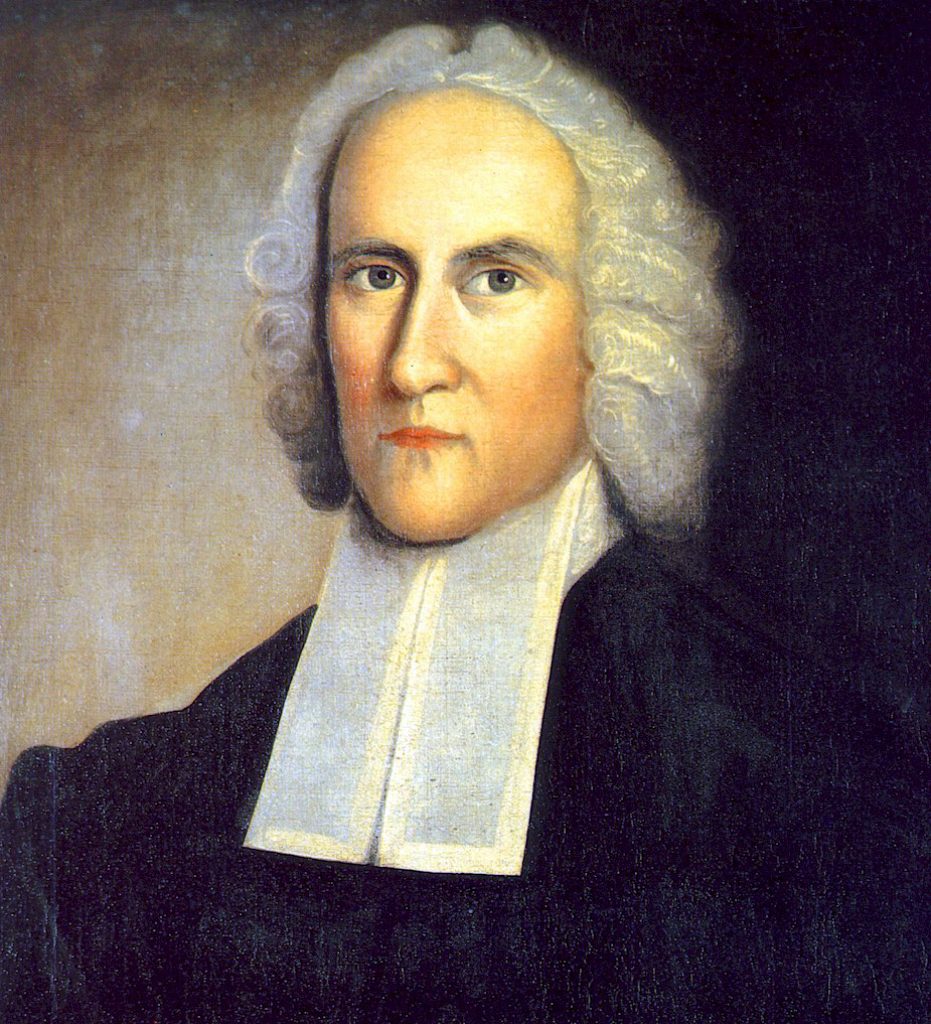
The Great Awakening, the flip side to the Enlightenment, was a series of religious revivals that affected every part of English America in the first half of the 18th century. Although some historians have argued that the experiences were too diffuse and spread over too long a tie to be considered a movement, others point out that revivals, wherever and however they happened, had aspects in common. The revivals expressed interior experience of salvation, emphasizing emotion rather than great learning. Many caught up in the experience characterized themselves as having been spiritually dead, merely going through the motions of worship, before being touched by the hand of God. Although the “awakeners’” theology stressed the Calvinist doctrine of human depravity, saying that sinful people could no nothing to lift themselves out of sin without divine help, the effect was energizing. Congregations left revival meetings feeling salvation was available to them if only they reached out and wanted badly enough to achieve it.
The Great Awakening affected all aspects, divisions, and spheres of British colonial society. Even many elites found themselves caught up in it, realizing the inadequacy of reasons alone to move their hearts. Above all, the first Great Awakening represented an unleashing of anxiety and longing among ordinary people living in a world of oral culture, anxiety about sin, and longing for salvation. The leaders of the Enlightenment and the Great Awakening viewed each other as adversaries; Enlightenment leaders were considered godless and the new preachers believed that the people in the ever-expanding western frontier needed preaching. On the other side, Enlightenment leaders scoffed at the ‘enthusiasts” lack of reason. Evangelicalism versus Rationality: The Enlightenment and the Great Awakening were two threads of this polemic.[19]
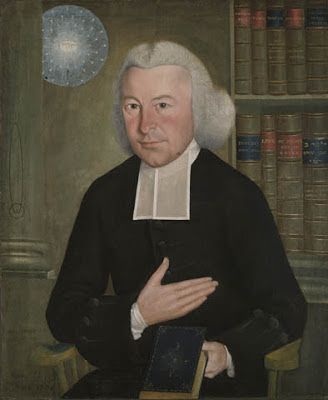
Colonists began losing their land (bad yields meant they could not pay their annual debts, so lending institutions or people took the land) so they blamed England, Church attendance began falling, so colonial preachers blamed England. More colonists became poor, so they blamed England. And some preachers sought to bring or scare people back to the established churches through emotional sermons (i.e., Solomon Stoddard and Jonathan Edwards).
Initially, to vote in a community, you had to belong to the town’s church. However, that slowly changed over time. In the 1720s, a young preacher named Solomon Stoddard in Massachusetts became alarmed to discover that not only was the church congregations falling in numbers, but he was extremely concerned that non-church members could vote on church matters. Stoddard wanted a revival of the old Puritan conversion. He counseled ministers to use emotionally charged sermons to bring people back to the established church. Stoddard’s grandson, Jonathan Edwards, picked up the baton. Edwards became concerned that activities of people (especially those that took place at night) as well as making money were more important to people than saving their own souls. He began fire and brimstone preaching, claiming that his congregation would experience a “brightness” in the conversion experience. One of his most famous speeches was entitled “Sinners in the Hands of an Angry God.”
“How dreadful is the state of those that are daily and hourly in danger of this great wrath and infinite misery! But this is the dismal case of every soul in this congregation that has not been born again, however moral and strict, sober and religious, they may otherwise be. Oh! that you would consider it, whether you be young or old! There is reason to think that there are many in this congregation, now hearing this discourse, that will actually be the subjects of this very misery to all eternity. We know not who they are, or in what seats they sit, or what thoughts they now have. It may be they are now at ease, and hear all these things without much disturbance, and are now flattering themselves that they are not the persons, promising themselves that they shall escape. If we knew that there was one person, and but one, in the whole congregation, that was to be the subject of this misery, what an awful thing it would be to think of! If we knew who it was, what an awful sight would it be to see such a person! How might the rest of the congregation lift up a lamentable and bitter cry over him! But, alas! instead of one, how many is it likely will remember this discourse in hell! And it would be a wonder, if some that are now present should not be in hell in a very short time, before this year is out. And it would be no wonder if some persons that now sit here in some seats of this meeting-house, in health, and quiet and secure, should be there before tomorrow morning!”[20]
In a nutshell, the re-solidification of the Puritan church did not transpire under Stoddard and Edwards, however the separation of church and state continued to grow.
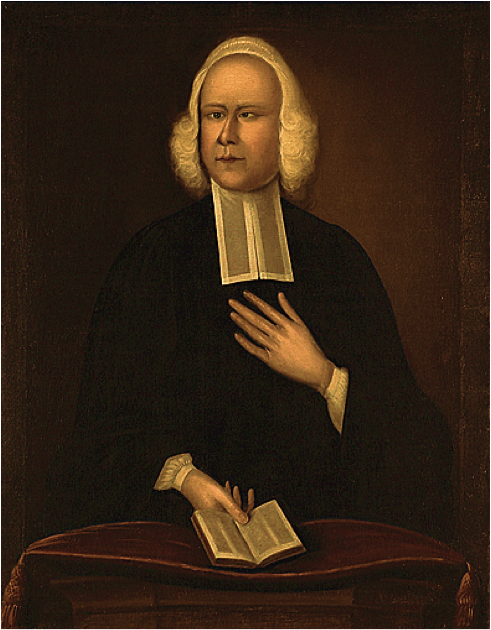
Another popular preacher was George Whitefield. He was invited to preach his extremely emotionally filled, and fire and brimstone like, style of revivalism from Boston to Georgia. In 1739, at the age of 27, he arrived in Philadelphia. People came from hundreds of miles to hear him preach. Thus, these people were forgoing their established churches and home-town preachers. Soon, thousands flocked to hear him urge a new birth through a sudden, emotional conversion. He also inspired others to travel to the frontier to preach. One of Whitefield’s supporters, interesting enough, was Ben Franklin. In 1739 Franklin wrote:
“In 1739 arrived among us from Ireland the Reverend Mr. Whitefield, who had made himself remarkable there as an itinerant preacher. He was at first permitted to preach in some of our churches; but the clergy, taking a dislike to him, soon refused him their pulpits, and he was obliged to preach in the fields. The multitudes of all sects and denominations that attended his sermons were enormous, and it was matter of speculation to me, who was one of the number, to observe the extraordinary influence of his oratory on his hearers, and how much they admired and respected him, notwithstanding his common abuse of them, by assuring them they were naturally half beast and half devils. It was wonderful to see the change soon made in the manners of our inhabitants. From being thoughtless or indifferent about religion, it seemed as if all the world were growing religious, so that one could not walk thro’ the town in an evening without hearing psalms sung in different families of every street.”[21]
Whitefield’s American tour inspired thousands to seek salvation. Most converts were young adults in their late twenties. Within four years of Whitefield’s arrival, every fifth person under the age of 45 had been “born again,” as Whitefield called the result of the conversion experience. However, Whitefield in specific and this religious revivalism in general, had its critics.
Whitefield’s critics argued that he tended to preach an unorthodox doctrine, his preaching disrupted regular church attendance, and that he threatened the authority of the established church. Whitefield’s insistence that anyone could be a preacher infuriated the established religious elite who were classically trained in theology (such as graduating from Harvard or Yale). One of Whitefield’s most outspoken critics was Charles Chauncy.
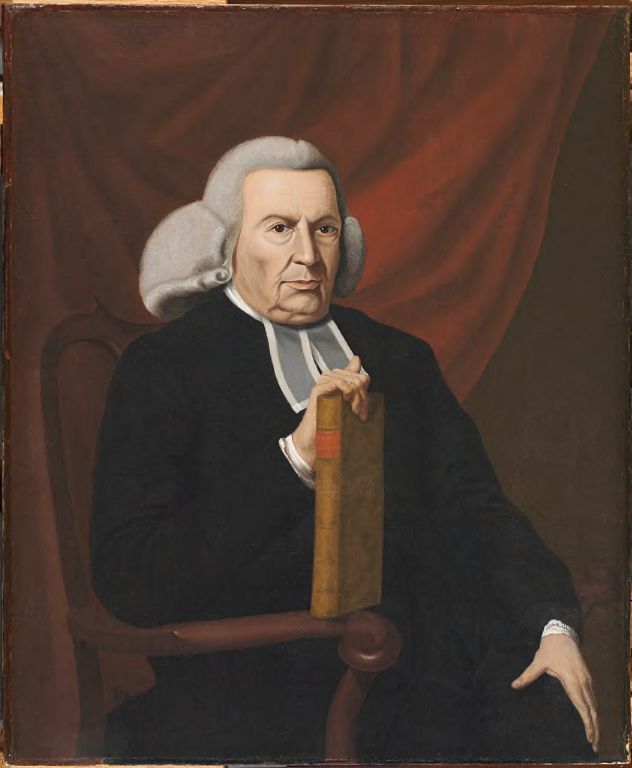
The conversion experiences during these tent revivals were outwardly physical: dancing, singing, seizures, rolling on the ground, barking like dogs. Extreme reaction was a sign to those in the crowd that they surely had been touched by the Hand of God.
Chauncy argued that Whitefield’s tent revivals and the “creation” of new ministers were simply product of human delusion. Chauncy believed that ministers needed to stay at home to preach to the community, that frontier ministers were uneducated in theology and doctrine, and that these “New Lights” (as they called themselves) were overturning the centuries old gender bias by allowing women (and in some cases free Africans and Indians) to preach. Chauncy felt that emotionalism was a womanly trait, and that preaching should a manly endeavor, stripped of emotional rhetoric. Chauncy even argued that Enlightenment “reason” was undermining the old church doctrine as both Enlightenment as well as the New Light preachers held a relaxed view on predestination (or in some cases disavowed predestination); the corner stone of Calvinism.
Solomon Stoddard started preaching at Northampton, Massachusetts, after 1669 and soon would be asked to be a regular pastor. Stoddard accepted in 1672 and maintained in that post until he died. During this time, Stoddard saw that the first generation of the church members was passing away, and many of their children showed scarce interest in being affiliated with the church. Being a part of the church was necessary due to the fact that membership was essential for citizenship. Stoddard would be soon to replace this ideology by adopting the “Half-Way Covenant.” This meant that the children of the members could be baptized, but would be considered half-members until they would demonstrate religious . However later, Stoddard would no longer regard whether they were full or half members and would open the privileges of being a member to all who could join.[23]
Stoddard was known to be a powerful preacher who would follow his advice and would encourage others as well. Due to his vigorous preaching and new evangelical concerns to preach revival.[24] Stoddard was able to create five great awakenings or “harvests,” which would be held at the church. Stoddard turned more souls to Christ than any other time in New England before the Great Awakening. Many of the pastors envied Stoddard because he had grown a bigger church by his teachings about revival. Solomon Stoddard was leading pastoral of sixty years, and due to failing health, this is where Stoddard’s grandson comes in. Jonathan Edward comes in and becomes the leading colonial advocate of the awakenings and America’s greatest theologian.[25]
When Stoddard died, Edwards became the minister of the second-largest church in the New England Colonies.[26] As Edwards got into his position, he developed the methods of his ministry. Edwards preached to a packed house of clergy, many of whom he pastured with have been doing it for many more years than Edwards had been alive. Later he was best known for his sermons, which emphasized how God judge the sinners, who would be saved, and how sinners should be prepared to receive the grace of God, but only grace through faith would be provided for salvation. Edward spent laboring over his sermons 12 to 14 hours per day. During the winter of 1734-35, Edwards work was rewarded because of the outbreak of religious enthusiasm in Northampton’s youth. Edwards preached his first sermon called “God Glorified in the Work of Redemption.” There appeared to be universal dependence of the redeemed on God, meaning salvation is a work of God from start to finish. For the next three years Edwards preached the Doctrines of Grace to his congregation in Northampton, Mississippi. The Doctrines of Grace meant the teaching of salvation is all of grace. In 1734, he then preached a sermon titled “A Divine and Supernatural Light.” This meant when dead souls rise to life, the blind eyes would see the beauty of the gospel, and when the deaf ears hear the transforming truth of the redemptive work of Christ, this will all be because of the divine and supernatural light. Later in 1741, Edward gave another sermon called “Sinners in the Hands of an Angry God”, which became very famous during the first great awakening. This sermon was to inform people that those who listen to the power of God ,repent their sins and beg for mercy would be the only way to keep them from falling into hell. Jonathan Edwards was seen as a great theologian of the Great Awakening.[27]
In 1740, Edwards sent a letter to George Whitefield, an Evangelical minister, inviting Whitefield to preach at his church. At that time, Whitefield had already been working as an itinerant Evangelical minister for many years. George Whitefield joined Charles Wesley in 1738 by doing missionary work. Wesley focused on translating the religious lessons into hymns, while Whitefield focused on preaching. The division in focus suggests that Whitefield may have gotten his extravagant way of teaching by traveling with Wesley. Whitefield’s central theme of preaching would be “New Birth,” which was the conversion experience. The sermons were described to be out of the ordinary because of his unique new ways of converting people. Whitefield would portray the lives of biblical characters with realism and would cry, dance, and scream to win them over. Whitefield sermons would consist of worship and prayer lasting until 2:00 am. The slave communities would be included, but Whitefield was nowhere near an abolitionist. Whitefield’s inclusion of the slave communities led to historians marking it as a genesis of African-American Christianity.[28] This would be another accomplishment for George Whitefield, which would identify him as a famous religious figure during the eighteenth century. Elizabeth Singer Rowe was inspired by Whitefield, leading her to write about gender roles. Writing would be the only way that women were able to proclaim their religious ideas. In 1741 she would become the leader of the Female Religious Society.[29]
In conclusion, every leader had a personal impact due to how they preached or the techniques they used. This altered the religious climate in the American colonies and increased personal connections with God instead of with a minister. Because of the leaders having an increase with the amount of people coming to church this lead to start of the Great Awakening.
During the very early colonial period, some colonies passed laws recognizing the supremacy of Trinitarians, or, prohibiting the belief in a unitarisn view of God, Jesus and the Holy Ghost. But by the First Great Awakening Unitarianism became widely accepted in the colonies. Rohan Dahal looked at Unitarianism during the First Great Awakening.[30]
Unitarianism as an organised church was first started in Poland and Transylvania in the 1560s.[31] After its formation, it slowly started spreading among different countries and was highly discussed by people in England by the mid 1600s in the writing of John Biddle. In America, unitarianism followed the same development as in England but was a reaction against the “First Great Awakening” of the 1740s and the Calvinist ideas that it contained. Historically, [the] Unitarian movement in America was not just an influence of European movement but still benefited from immigrants and visitors from Europe like Joseph Priestley.
Unitarians believed in social action, ideology and the goodness of humans. According to Unitarianism, Jesus is a simple man and God is one (the Mother or the Father) and is in present things.[32] They rejected the notion of the Trinity, a fundamental precept of Catholic, Orthodox, and most Protestant churches, as being irrational.[33] This quickly accelerated as a backlash against the “Great Awakening” under Jonathan Edwards and George Whitefield. Pastor of the west Church in Boston, Massachusetts Jonathan Mayhew and the pastor of the First Church Charles Chauncy were the most prominent men who preached the strict unity of God, the subordinate nature of the Christ, and salvation by character in the 1700s. They were the chief opponent of Edwards in the great revival. By the 1800s, there were many successful Unitarians in United States like Ebenezer Gay, Samuel West, Thomas Barnard, John Prince, William Bentley, Aaron Bancroft and many others who promoted the backlash against the Great Awakening.
Unitarianism ideas and views were spreading in America during the mid 1700s. However, Episcopalian King’s Chapel in Boston, Massachusetts was the first church to officially accept the Unitarian faith and James Freeman, minister of King’s Chapel was the first man to call himself a Unitarian, and revised its book of Common Prayer by removing all Trinitarian forms into a mild Unitarian liturgy in 1785.[34] People started publishing essays and writing covering the fact about Unitarians in America. Visiting The United States by William Hazlitt, the father of essayist and critic published the fact that were Unitarians in different cities of the United States like Boston, Pittsburgh, Philadelphia, Charleston and many more. These writing and essay were helping Unitarians to spread everywhere around the world. Unitarian congregations were started to organized and different churches started accepting the more liberal faith like First Church in Plymouth. People started migrating to the United States and organized a Unitarian Church like one at Northumberland, Pennsylvania and one in Philadelphia in 1796 by Joseph Priestley who came to the United States in 1794. Unitarian books started publishing after the high acceptance of Unitarians’ faith in late 1700s by John Sherman and Noah Worcestor.
Unitarians were willing to consider new ideas and they supported and encouraged individual freedom, equality for all and their thoughts. They started as a reaction to the Great Awakening under Jonathan Edwards and George Whitefield which later spread in many cities of the countries. Unitarians played an important role in changing religious belief of people in American History.
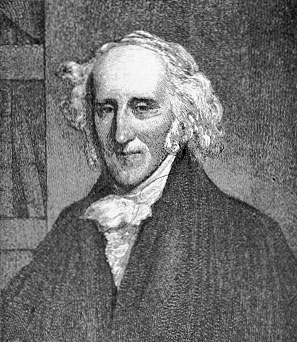
New Lights: Towards Independent Thinking and Independence
The New Lights (Baptists, Methodists, etc.) called upon people to renounce the established church which was “encrusted with hypocrisy and intellectualism” (just like the Enlightenment). They argued that people did not need ministers because people could take charge of their own salvation through belief in Jesus and good works. In fact, people did not even need to attend church service or belong to any church. Those who opposed the New Lights were called the Old Lights (Puritans, Anglicans, etc.). The New Lights called upon people to be self-thinkers (especially in the frontier and rural south).[35]
The established Puritan and Anglican churches lost members, which fueled the resentment of the Old Lights towards the New Lights and politically the Great Awakening threatened to separate the established churches from the colonial governments who supported an official colonial church. New England Puritanism and Anglicanism was undermined, some new sects went towards the Enlightenment (such as the Unitarians) and caused class divisions on a social level: Old Lights, the educated and ruling elites versus the New Lights, those lacking traditional or any formal education who had neither social or political status in the colonies.
Ironically, the outcome of the Great Awakening backfired on those who tried to scare people back to the established church and to solidify the ties between the established church and the colonial governments.
Conclusion
The aura of sanctified purpose around George Whitefield and his religious revival lingered even after his death in Boston in 1770. In September of 1775, a ragtag army of American rebels, marching through Massachusetts, paused on their way to attack the British stronghold at Quebec. Hoping to win a blessing from their risky venture, they broke open Whitefield’s tomb and prayed over the holy man’s remains.[36]
Historians argue that the Great Awakening was a powerful influence on eventually independence for the American colonies. If you can open the gates of separation by leaving the established church, then what came next was leaving England.
Both the Old Lights and the New Lights sought to break away from the established churches, churches with ties to England. And bot the New Light and Old Light Leaders tended to embrace and preach about the ideas of John Locke, especially those pertaining to life, liberty and property. New Lights established new colleges to train ministers in the new way of preaching and thinking: Princeton, Dartmouth, and Brown. The New Lights rejected the cold rationalism of the Puritans and Anglicans and instead forwarded the idea of emotionalism (the heart over the mind). The New Lights were open to trying, accepting, and tolerating new religious, economic, social, and political ideas.[37]
Both movements emphasized individual decision-making and independent thinking. However, while the Great Awakening failed to achieve its desired results of a return to the repository of Puritan doctrine, the Great Awakening did result in a more tolerant society towards other Christian sects and helped to establish the principle of separation of church and state and eventually both played parts in developing independent thinks who reached the conclusion that not only do the colonies not need the Anglican church, the colonies do not even need England, eventually.
I’d like to especially thank my students for their interest in colonial culture who made this chapter more there own: Eduardo Aguliar-gasca, Emely Alvarez, Ashley Berlanga, John Cox, Jarany Damian, Alvin David, Joshua Montgomery, Danny Montiel, Damaris Morin, Tiffany Nieto, Mario Olivo, Victoria Perez, Jaime Rodriguez, Aurore Angue Mbo and Rohan Dahl.
.
As with the other chapters, I have no doubt that this chapter contains inaccuracies. Please point them out to me so that I may make make this chapter better. I am looking for contributors so if you are interested in adding anything at all, please contact me at james.rossnazzal@hccs.edu.
- Ms. Mbo was a student of mine in US History, Fall 2019. ↵
- Walker, Rachel. “Cotton Mather Written By Rachel Walker.” Salem Witch Trials: Cotton Mather. Benjamin Ray and The University of Virginia, 2001. http://salem.lib.virginia.edu/people/c_mather.html. ↵
- Mather, Cotton, 1663-1728. Diary of Cotton Mather. [1957?]. Retrieved from the Digital Public Library of America, http://catalog.hathitrust.org/Record/004389610. (Accessed October 15, 2019.) ↵
- Ibid. ↵
- ] Mather, Cotton, 1663-1728. The Wonders of the Invisible World. Being an Account of the Trials of Several Witches Lately Executed in New England. To Which Is Added, A Farther Account of the Trials of the New-England Witches. London:J.R. Smith, 1862. ↵
- Williams, Tony. The Pox and the Covenant: Mather, Franklin, and the Epidemic That Changed Americas Destiny. Naperville, IL: Sourcebooks, 2011. ↵
- These people were my students in the Fall of 2019. ↵
- Watson, H. (2018). Building the American Republic, Volume 1:A Narrative History to 1877. University of Chicago Press: 1427 E. 60th Street Chicago. ↵
- Locks, C., Mergel, S., Roseman, P., Spike, T. & Lasseter, M. (2013). "History in the Making: A History of the People of the United States of America to 1877". History Open Textbooks, 1. ↵
- https://museumofcthistory.org/2015/08/john-winthrop-jr/ ↵
- http://www.newenglandhistoricalsociety.com/when-john-winthrop-jr-doctored-the-connecticut-colony-for-free/ ↵
- New London became a hospital town to which patients came from all over New England seeking cures for a host of medical conditions. To help meet the New England-wide demand for his medicines, Winthrop distributed them through a network of female practitioners, elite wives who incorporated Winthrop's color-coded packets of medicines into their own healing services. ↵
- http://www.newenglandhistoricalsociety.com/when-john-winthrop-jr-doctored-the-connecticut-colony-for-free/ ↵
- http://www.newenglandhistoricalsociety.com/when-john-winthrop-jr-doctored-the-connecticut-colony-for-free/ ↵
- http://sitn.hms.harvard.edu/flash/special-edition-on-infectious-disease/2014/the-fight-over-inoculation-during-the-1721-boston-smallpox-epidemic/ ↵
- Buhr, S. To Inoculate or Not to Inoculate?: The Debate and the Smallpox Epidemic of 1721. Constructing the Past 2000. 1:61-67. ↵
- http://sitn.hms.harvard.edu/flash/special-edition-on-infectious-disease/2014/the-fight-over-inoculation-during-the-1721-boston-smallpox-epidemic/ ↵
- Best, M. Neuhauser, D. and Slavin, L. “Cotton Mather, you dog, dam you! I’l inoculate you with this; with a pox to you”: smallpox inoculation, Boston, 1721. Quality and Safety in Health Care 2004.13:82-83. ↵
- I do not have in my notes where I originally came across this information. ↵
- https://wwnorton.com/college/history/archive/resources/documents/ch03_03.htm ↵
- http://www.ushistory.org/franklin/autobiography/page49.htm ↵
- These were some of my students from the Fall of 2019. ↵
- “Historic Highlights: Solomon Stoddard,” Historic Northampton, Accessed October 18, 2019, http://www.historic-northampton.org/highlights/stoddard.html . ↵
- “Solomon Stoddard Facts: Solomon Stoddard,” Your Dictionary, Accessed October 18, 2019, https://biography.yourdictionary.com/solomon-stoddard . ↵
- “Historic Highlights: Solomon Stoddard,” Historic Northampton, Accessed October 18, 2019,http://www.historic-northampton.org/highlights/stoddard.html . ↵
- Nichols , Stephen J .” Jonathan Ewards and the First Great Awakening.” Banner of TruthModified August 1,2018https://banneroftruth.org/us/resources/articles/2018/jonathan-edwards-and-the-first-great-awakening/. ↵
- Nichols , Stephen J .” Jonathan Edwards and the First Great Awakening.” Banner of Truth Modified August 1,2018 https://banneroftruth.org/us/resources/articles/2018/jonathan-edwards-and-the-first-great-awakening/ . ↵
- “Class 10: Wide Awake In (Colonial) America: Puritanism, Jonathan Ewards & GeorgeWhitefield.” Capitol Hill Baptist Church. Modified Jun 24,2016.https://www.capitolhillbaptist.org/sermon/class-10-wide-awake-in-colonial-america-puritanism-jonathan-edwards-george-whitefield/ ↵
- Vasquez , Julia. “Women.” The Great Awakening. Modified April 9 ,2014https://project2group5.weebly.com/women.html#targetText=Through%20women%20suc ↵
- Mr. Dahal was a student of mine in US History in the Fall of 2019. ↵
- “Religions - Unitarianism: History of Unitarianism.” BBC. BBC, September 21, 2009. https://www.bbc.co.uk/religion/religions/unitarianism/history/history.shtml ↵
- Zastoupil, Lynn. "Defining Christians, Making Britons: Rammohun Roy and the Unitarians." Victorian Studies44, no. 2 (2002): 215-43. http://www.jstor.org.libaccess.hccs.edu:2048/stable/3830327. ↵
- Robertson, Pat. “What Do Unitarians Believe?” CBN.com, July 5, 2019. https://www1.cbn.com/questions/what-unitarians-believe. ↵
- Sutton, Ian. "Unitarians and the Construction of History and Biography, 1740–1820." The English Historical Review 125, no. 513 (2010): 314-39. http://www.jstor.org.libaccess.hccs.edu:2048/stable/25639998. ↵
- https://books.google.com/books?id=j-ofqWZ-b1cC&pg=PA8&lpg=PA8&dq=the+established+church+which+was+encrusted+with+hypocrisy+and+intellectualism&source=bl&ots=-CVfzEDaaX&sig=ACfU3U3D2-eTVbr4DIa-5UmSHmOqCqFtog&hl=en&sa=X&ved=2ahUKEwjm7OKHga3kAhVBI6wKHRjjB5cQ6AEwAHoECAcQAQ#v=onepage&q=the%20established%20church%20which%20was%20encrusted%20with%20hypocrisy%20and%20intellectualism&f=false ↵
- My notes do not say where I got this section from, but I do not think I wrote "aura of sanctified purpose." ↵
- http://faculty.polytechnic.org/gfeldmeth/lec.ga.html ↵
